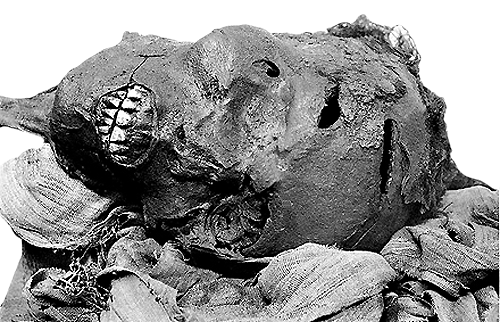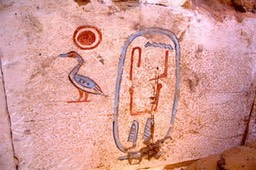Somewhere during the reign of Amenemhat IV, the penultimate king of the 12th Dynasty, the regular expeditions to the copper and turquoise mines of the Sinai came to a stop. At about the same time, the archaeological record shows that a man of obvious foreign origin, usurped royal power and controlled at least part of the Nile Delta. He was succeeded by a long list of foreign kings, whose control never seems to have exceeded Lower Egypt and that are grouped in the 14th Dynasty, which ruled from the city of Avaris.
The circumstances under which a foreigner was able to seize power over a prosperous region in the country, are not known. Perhaps Amenemhat IV's non-royal parentage caused some dynastic feud with the remaining members of the old royal family, weakening the position of the central government. The fact that Amenemhat IV’s immediate successor, Nefrusobek, was not one of his surviving sons, but a daughter of Amenemhat III, may have been an ultimate attempt of the members of the 12th Dynasty to hold on to power.
That this attempt, if that is indeed what it was, failed, is shown by the fact that Nefrusobek's successor, Sebekhotep I, was the son of Amenemhat IV and thus no longer a member of the 12th Dynasty. Sebekhotep I is therefor considered to be the founder of the 13th Dynasty, which ruled Upper-Egypt from Itj-Tawi near the Fayum oasis and Memphis, while the 14th Dynasty held power over at least the eastern part if not the whole of Lower Egypt.
The tombs of the early 14th Dynasty in the Delta contained several military objects, which could indicate that the relationship of this Lower Egyptian Dynasty with the last rulers of the 12th and the first rulers of the 13th Dynasties may have been of a military nature. That any initial hostilities between the Upper and the Lower Egyptian Dynasties were ended soon is shown by the fact that the kings of the 13th Dynasty were able to trade with the Near East, while the 14th Dynasty could trade with Nubia, each dynasty thus allowing the other one a safe passage on its trading routes.
Sebekhotep V presenting an offering.
Despite the initial rivalery and the kings of the 13th Dynasty still officially claiming kingship over the entire country, the first halves of both concurrent dynasties appear to have been fairly stable. The second part of the 13th Dynasty, however, was marked by usurpations and kings openly proclaiming their non-royal birth. At the same time, the kings of the 14th Dynasty became more and more ephemeral figures. The last kings of the two dynasties followed each other in rapid succession which drastically weakened the authority of their governments.
Remarkably, several kings of the second half of the 14th Dynasty, had the word nourishment as part of their royal names, an indication that the provisions of food become a topic of high political importance. At the same time, burials in Avaris, the capital of the 14th Dynasty, often lacked the usual food offerings and have the character of quick mass interments. All of this appears to point towards famines ravaging the otherwise very fertile Nile Delta. The results of these famines may have been felt throughout the entire country. Not only may there have been a general lack of food in the whole of Egypt, but famines quite often resulted in plagues which explain the quick succession of kings in both Dynasties.
As a result of the weakened positions of the 13th and 14th Dynasties, Egypt lay open to any outside aggression. At around 1640 BC, Egypt was invaded by a group of Canaanites, whose leader used the title HqA-xAs.wt, ‘ruler of the foreign land’, or Hyksos.
The Hyksos easily conquered Avaris as well as Memphis, causing the end of both the 13th and 14th Dynasty and founding their own dynasty, the 15th Dynasty. The fall of the 13th Dynasty created a power vacuum in the southern part of Upper-Egypt, which was quickly filled by two local dynasties: one in Abydos and one in Thebes, the latter's power extending from Thebes to Aswan in the South. The kings of the Theban dynasty are grouped in the 16th Dynasty.
At the same time, the Hyksos pressed on further to the South as well, and after it had been independent for about 20 years, they made an end to the Abydene Dynasty. It would take them another 30 years before they would successfully end the 16th Dynasty and enforcing their rule upon the entire country.
The Hyksos kings, however, were not able to maintain their control over the whole of Egypt, and only a few years after it had been conquered, Thebes again arose as an independent state, and home to the 17th Dynasty. The circumstances that led to Thebes' renewed independance are not clear. A change of power in the 15th Dynasty may hint at some dynastic troubles among the Hyksos, and it is possible that the Thebans took advantage of the situation not only to reclaim their autonomy but also to extend their rule as far North as Abydos.
After the Theban conquest of Abydos, a status quo appears to have been established between the 15th and 17th Dynasty and both dynasties even appear to have entered into trade. This situation lasted at least until the reign of Seqenenre, the penultimate king of the 17th Dynasty, during which hostilities between the Thebans and the Hyksos appear to have been reinitiated. A Ramesside story relates about a quarell between Seqenenre and Apophis, the penultimate king of the 15th Dynasty. The historicity of this story can, of course, be doubted, but the mummy of Seqenenre shows signs of a violent death, consistent with the weapons that the Hyksos could have used.

Head of the mummy of the 17th Dynasty king Seqenenre, showing different wounds that are consistent with a violent death.
The first historically recorded traces of a war against the Hyksos are dated to the reign of Seqenenre's successor, Kamose. Two stelae commemorate Kamose's struggle against the Hyksos and their vassals. Against the advice of his council, Kamose started or continued the war, punishing all those who had collaborated with the foreigners.
It would be Kamose's successor, Ahmose, who would finally succeed in overthrowing the Hyksos. With his reign, a new period of prosperity and wealth would begin: the New Kingdom.
Click on the thumbnails below to learn more about the dynasties of the 2nd Intermediate Period:
